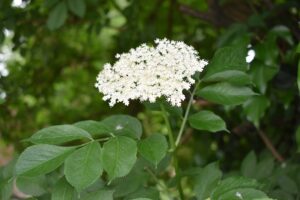Elder – Sambucus Nigra

The Elder is a shrub or a small deciduous tree of the Adoxaceae or Caprifoliaceae family, widespread in Europe and Italy.
Always used for therapeutic purposes, in the peoples of northern Europe it was called the pharmacy of the Gods. Even today its qualities are appreciated, in fact, parts of the plant are used to be transformed into phytotherapeutic preparations or for food purposes.
In nature, the elderberry can take on both the shape of a tree and a shrub, reaching a height of about ten meters and presenting itself with an expanded and dense crown, with a globular shape.
The root system is superficial, with a very intense polloniferous activity, which contributes to the expansion of the tree.
It has an erect and very branched trunk. The branches start from the bottom and are opposite, with an arched and drooping trend. The trunk has a twisted and irregular shape, with many knots. The bark is brownish-gray in color, with a wrinkled surface furrowed with deep cracks.
The section of the branches and the trunk is very characteristic: a central pith of white color, with a soft and elastic consistency. For this reason it is easy to empty it and use the wood to create small handcrafted tools or precious musical instruments.
Terrain
The Elder can tolerate at most the first 4-5 years of life in pot (with annual repotting in 2 more sizes), then they must be planted in the garden; It adapts well to any soil, as long as it is rich and humid (but not too compact and clayey). It is advisable to expose it in full or half sun, to increase its inflorescence and it does not require any winter and summer precautions to ensure its vitality. When the plant is in pot, the water requirement must be abundant and regular from May to September as soon as the substrate dries up; when the plant is in the open ground, irrigation must be abundant only in the first months after planting, if it occurs in spring.
Flowers adn fruits
The flowers of the Elder are small, white / cream and star-shaped, they are gathered in umbrella-shaped inflorescences, which can reach up to 20 cm in diameter.
Flowering occurs from late spring and lasts for the entire month of July, they are widely used in the herbal, phytotherapeutic and food fields.
The fruits of the elder are very small, globular berries. At first their color is green, then dark purple and blackish. When fully ripe they are shiny and juicy and contain from 2 to 5 oval and brown seeds inside.
The drupes are grouped in falling infructescences, placed on reddish peduncles.
The fruits arrive at full maturity from the end of August and remain on the tree until late October.
It is very important to pick them when they are fully ripe, when unripe they contain higher concentrations of a substance toxic to humans if taken in high quantities.
With the cooking and extraction processes, toxic substances are eliminated.
These berries are also an important food for many bird species.
The leaves of the elderberry are deciduous, that is, they fall in autumn-winter. They are petiolate type, opposite on the branches, oval in shape with pointed apex.
Their color is bright green, and when rubbed together they give off a very unpleasant odor.
Use and heathcare content
In general, the plant has emollient, sweat, diaphoretic, laxative and diuretic properties. It has always been used in colds, to bring down fever, and in neuralgia. As mentioned in folk medicine, elderberry was considered a real panacea.
The most used parts in herbal medicine are the flowers and fruits.
The raw ripe fruits are strongly laxative and purifying and contain high quantities of vitamins A and C. The strong laxative power induces to use the berries, after cooking, for example to make elderberry juice or syrup. In fact, in these preparations, the laxative effect is attenuated.
Fruit extracts (juice and syrup) have always been used in the treatment of stomach cramps.
The berries are still used to prepare a well-known alcoholic drink, sambuca.
In the kitchen, ripe berries can turn into tasty jams.
In ancient times, the juice of the elderberries was used as a natural dye, to color leather and natural fibers or to produce ink.
The flowers are used for both internal and external use. With these, a useful syrup is prepared to alleviate fever, bronchitis, states of constipation.
For external use, the flowers have astringent properties and a soothing action on the skin. Lotions prepared with elderflower extracts are used to normalize sebum secretion and skin impurities. They are therefore used on boils, sunburn and for the treatment of hemorrhoids.
